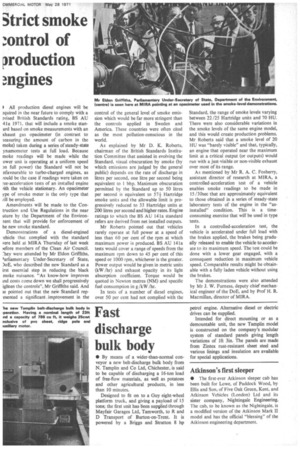strict smoke :ontrol of yoduction ngines
Page 41

If you've noticed an error in this article please click here to report it so we can fix it.
All production diesel engines will be >attired in the near future to comply with a :Ivised British Standards rating, BS AU 41a 1971, that will include a smoke stanard based on smoke measurements with an thaust gas opacimeter (in .contrast to leasuring the amount of carbon in the moke) taken during a series of steady-state ynamometer tests at full load. Because moke readings will be made while the oWer unit is operating at a uniform speed mi full power) the Standard will not be nfavourable to turbo-charged engines, as (ottid be the case if readings were taken on ee-acceleration tests of an installed engine dth the vehicle stationary. An opacimeter ype of smoke meter is the only type that rill be employed.
Amendments will be made to the Contruction and Use Regulations in the near uture by the Department of the Environ[lent that will provide for enforcement of he new smoke standard.
Demonstrations of a diesel-engined 'chicle that complied with the standard vere held at MIRA Thursday of last week lefore members of the Clean Air Council. :hey were attended by Mr Eldon Griffiths, 'arliamentary Under-Secretary of State, )0E, who described the new Standard as a irst essential step in reducing the black moke nuisance. "As know-how improves ind costs come down we shall progressively ighten the controls", Mr Griffiths said. And te pointed out that the new Standard repesented a significant , improvement in the control of the general level of smoke emission which would be far more stringent than the controls applied in Sweden and America. These countries were often cited as the most pollution-conscious in the world.
As explained by Mr D. K. Roberts, chairman of the British Standards Institution Committee that assisted in evolving the Standard, visual obscuration by smoke (by which emissions are judged by the general public) depends on the rate of discharge in litres per second, one litre per second being equivalent to 1 bhp. Maximum obscuration permitted by the Standard up to 50 litres per second is equivalent to 57+ Hartridge smoke units and the allowable limit is progressively reduced to 33 Hartridge units at 200 litres per second and higher rates. Engine ratings to which the BS AU 141a standard refers are derived from net installed outputs.
Mr Roberts pointed out that vehicles rarely operate at full power at a speed of less than 60 per cent of the rpm at which maximum power is produced. BS AU 141a tests would cover a range of speeds from the maximum rpm down to 45 per cent of this speed or 1000 rpm, whichever is the greater. Power output would be given in metric units (kW /hr) and exhaust opacity in its light absorption coefficient. Torque would be quoted in Newton metres (NM) and specific fuel consumption in g /kW /hr.
In tests of a number of diesel engines, over 50 per cent had not complied with the Standard, the range of smoke levels varying between 22/25 Hartridge units and 70 RU. There were also considerable variations in the smoke levels of the same engine model, and this would create production problems. Mr Roberts said that a smoke level of 20 HU was "barely visible" and that, typically, an engine that operated near the maximum limit at a critical output (or outputs) would run with a just-visible or non-visible exhaust over most of its range.
As mentioned by Mr R. A. C. Fosberry, assistant director of research at MIRA, a controlled-acceleration test of a vehicle enables smoke readings to be made in 15 /30sec that are approximately equivalent to those obtained in a series of steady-state laboratory tests of the engine in the "asinstalled" condition. This is a timeconsuming exercise that wilI be used in type tests.
In a controlled-acceleration test, the vehicle is accelerated under full load with the brakes applied, the brakes being gradually released to enable the vehicle to accelerate to its maximum speed. The test could be done with a lower gear engaged, with a consequent reduction in maximum vehicle speed. Comparable results might be obtainable with a fully laden vehicle without using the brakes.
The demonstrations were also attended by Mr J. W. Furness, deputy chief mechanical engineer of the DoE, and by Prof H. R. Macmillan, director of MIRA.










































































































